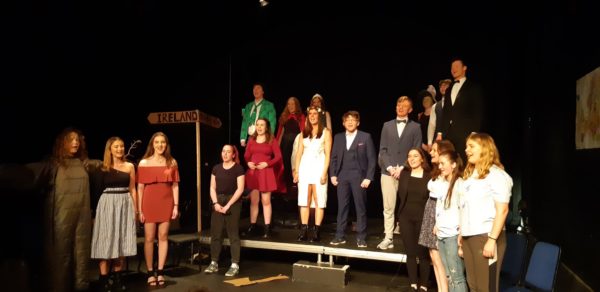
For anyone who sat the leaving certificate within the last few years, the title Oisín i dTír na nÓg will probably bring back painful memories of soul-destroying Irish essays. An Cumann Gaelach’s musical adaptation of the folklore tale, however, is a much more enjoyable ordeal. Dillon Cotter’s original script is fresh and funny, while the music is charming and endearing.
The story begins in the same way as the fairytale, but soon deviates onto a path of its own. Princess Niamh invites Oisín, an Irishman who doesn’t speak Irish, to her mystical home of Tír na nÓg. Unbeknownst to Oisín, she intends to marry him solely to spite her father, who despises the English language and all those who speak it.
Chaos ensues as Oisín attempts to learn the language, with Niamh scheming to wriggle out of both her own would-be sham marriage, and the alternative arranged marriage with which her father has threatened her. Cotter’s script flows well, and the original music is impressive if somewhat overshadowed by re-workings of more familiar pieces, including a certain Les Mis number.
The show is carried by a stellar cast, who embrace the comical nature of the script. Mel Swords’s Oisín is charismatically clueless, convincingly portrayed as not having a word of Irish despite Swords being a Gaeilgeor himself. Niamh, played by Jenny Dolan, is resoundingly headstrong and sassy, with Dolan’s vocals shining through in Niamh’s solo number in the second act. The supporting cast are similarly impressive – Robert Murphy and Mary-Kate O’Harte, playing Kevin and Siobhán respectively, are at the centre of much of the comedy.
Niamh’s gaggle of friends bring a wonderful energy to the stage, and David Kehoe’s St Patrick is nothing short of hilarious. Cotter’s characters aren’t particularly complex, but they are very entertaining. Collectively, the cast don’t take themselves too seriously, while still putting on a professional performance.
Much of the comedy comes from quintessentially “Irish” humour – hysteria surrounding the módh coinníollach, the elusiveness of the fáinne óir, jokes about Irish-language competitive debating. There is also the trope of the Irish alcoholic party animal, but the character in question, St Patrick, makes for an amusing use of the cliché.
The most entertaining cultural humour is arguably Niamh’s father, who comes across as the personification of every Irish student’s experience of Irish college with his unabashed condemnation of the English language. While this type of comedy may fly over the heads of some audience members, most will appreciate the trademark Trinity jokes, from sly digs at University College Dublin (UCD) to a pair of Jailbreak competitors wandering on stage looking for directions.
The comedy continues right up to the end, but Niamh’s speech in the final scenes about bilingualism and respect for both English and Irish is an unexpected but welcome final touch. Remarking that the use of the two languages should not be viewed as mutually exclusive, she perfectly summarises what the Cumann Gaelach is all about.
While the musical may not be a flattering appraisal of the Irish language on the surface – Niamh goes to Ireland specifically to find a suitor who does not speak Irish – it is the perfect way to build an association of positivity and respect with the language.
Oisín I dTír na nÓg, then, may not be the most polished show to be put on in the Players theatre, but it is a fun, uplifting spectacle that is by no means limited to fluent Irish speakers – rather, those with limited Irish will likely leave with a sense of pride in the cúpla focail they could appreciate in the script.






